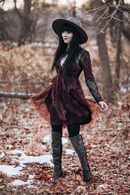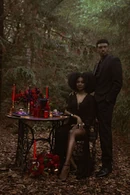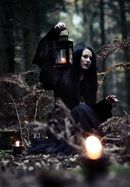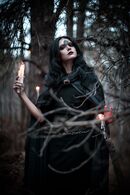| This page needs work. Please help us by expanding it. If you aren't sure how to help, check the article guide Format and Content Reason: Former "woodland goth" page that needs to be adjusted. |
Strega is a fashion style and aesthetic centering around the concept of a forest witch. While it always has existed in some form or another as part of the larger Goth subculture, it wasn't until the mid-2010s that it was given an own name that is derived from the latin word for witch "Stregeria". As the name suggests, the aesthetic draws inspiration from the existing witch community, particularly those who are also part of the Goth subculture.
History[]
The Goth subculture always embraced witch-inspired style but also has recently gained recognition outside of the scene. While Strega fashion is influenced by the witch culture, its roots trace back to the dark variant of the Japanese Mori Kei style.
The major purveyor of this in the 80s, both lyrically and visually, was Siouxsie and the Banshees, who moved from grotesque Steven King fare to the more mystical and dream-like in songs like “Spellbound”, “Red Over White”, and “Green Fingers”. (Even going so far as to filming their own version of Alice in Wonderland.)
Meanwhile, Bauhaus wrote the song “Hollow Hills” in reference to Brian Froud and Alan Lee’s Faeries. The album covers and music videos of 4AD’s This Mortal Coil featured ethereal, often forested imagery. Danielle Dax potrayed Wolf Girl in The Company of Wolves, based on Angela Carter’s The Bloody Chamber.
The literary influences came full circle as the fey side of the Goth scene began to influence the fantasy, fairy tale retellings, and urban fantasy of the day. In art, Brian Froud adopted gothic visuals for the movie Labyrinth. In books, Terri Windling’s Borderland anthologies and Emma Bull’s War For the Oaks were overtly a hybrid of fae mythology with proto-Goth imagery.
The influence of this then-nameless movement-within-a-movement has persisted in literary, artistic, and musical works up into the modern era and on social media.
Styles used by certain Strega-type bands helped to originate 90s Hippie Goth and Romantic Goth. But while Hippie Goth is often just boho clothes with dark colors and makeup, Strega tends towards Pre-Raphaelite influences and color schemes as well as the distinctive use of brocade, velvet, and glitter.
Visuals[]
The Strega aesthetic tends to feature darkly dream-like, sometimes natural imagery, such as:
- Misty forests
- Moon and stars
- 20s theatre/ballet photos
- Moths
- Unusual insects
- Tea things
- Swans/wings
- Bare trees and twigs
- Thorns
- Underwater
- Blurry images
- Stained glass windows
- Glitter/shimmer
- Dancing figures
- Black cats
- Candles and old lamps
Fashion[]
While Strega fashion is similar to Mori Kei in that it features natural, layered clothing, it also adopts a color scheme of black, dark gray, browns, and earth tones, distinguishing itself from the typically off-white hues of Mori Kei. It also may incorporate earthy greens, brick reds, and rich violets while staying true to its Goth roots.
Strega typically incorporates symbolic elements such as pentacles, long dresses, and gender-neutral clothing, reflecting the word's gender neutrality. The style often features loose clothing, reminiscent of medival forest wear, a nod to the daily activities of witches practicing their magick. With layered garments and high boots, the outfits not only exude a mystical vibe but also offer practical protection. The prevalent use of black in Strega fashion stems from its symbolic association with protection in the witch community. To make the overall appearance more mysterious, mufflers and overcoats are often incorporated into Strega fashion. They not only contribute to the aesthetic but also serve practical purposes, helping in discreet exits from unwanted situations—a seemingly ideal ensemble for introverts—and, of course, providing an extra layer of protection from harm.
Strega also heavily rellies on symbolism associated with witchcraft such as pentagrams, antlers, and crow feathers. There's also many outfits that embrace a bohemian aesthetic inspired by traveling witches. If you aim to create a look based on a specific type of witch that actually exists among practicers in real life it is recommend to do proper research in order to ensure accuracy and alignment with the desired aesthetic.
Media[]
It has inspired much of 80s era fantasy and urban fantasy, but in general it lends itself to shadowed, ethereal atmospheres. Dark Victorian fairy paintings, jewel tone color schemes, Pre-Raphaelite art, shimmery forests, ballroom/masquerades, and classic ballet/modern dance imagery tend to fit.
Comics[]
- Charles Vess' Book of Ballads and Sagas
- Neil Gaiman's Sandman: A Midsummer Night’s Dream
TV Shows[]
- Beauty and the Beast (80s)
- Once Upon A Time
- Shelley Duvall's Faerie Tale Theatre
- Princess Tutu
Movies[]
- Labyrinth (1986)
- Ridley Scott’s Legend (1985)
- The Company of Wolves (1984)
- The Dark Crystal (1982)
- The Red Shoes (1948)
- BBC Alice in Wonderland (1966)
- Valerie & Her Week of Wonders (1970)
Books[]
- The Faerie Handbook
- Terri Windling’s Borderland series
- War For the Oaks by Emma Bull
- Winter Rose by Patricia A. McKillip
- The Door in the Hedge by Robin McKinley
- Roses and Rot by Kat Howard
- Honeycomb by Joanne M. Harris
- An Enchantment of Ravens by Margaret Rogerson
- Into the Heartless Wood by Joanna Ruth Meyer
- The Goblin Market and Other Poems by Christina Rossetti
- House of Pomegranates by Oscar Wilde
- Faeries by Brian Froud and Alan Lee
- Blue Rose: An ACE Roleplaying Game
- Changeling: The Dreaming
Ballets/Operas[]
These are a few that influenced certain imagery (but were not inspired by this aesthetic, as they predated it).
- Giselle
- Swan Lake
- La Sylphide
- Loie Fuller's La Mere
- Pina Bausch's Orpheus and Eurydike
- Martha Graham's A Diversion of Angels
- Sleeping Beauty: A Gothic Romance
- Rusulka
- Richard Wagner’s Die Feen
- A Midsummer Night’s Dream (40s)
Artists[]
- Brian and Wendy Froud
- Charles Vess
- John Anster Fitzgerald
- Kinuko Y. Craft
- Nene Thomas
- Amy Stokes
References[]
Bohemian Manifesto: A Field Guide to Living On the Edge by Lauren Stover discusses Fairy Goth, which is extremely similar to Strega.
Music[]
As this is a Goth subgenre, Goth music and bands are associated, particularly those that explore folkloric subject matter. The vocalists are typically unusual, banshee-esque, and even operatic in their range. It’s also common to see folk rock influences.
Ethereal wave is by far the most dominant Goth genre to find this aesthetic in, particularly from the mid-80s 4AD (and later, Sam Rosenthal’s Projekt) indie record label. Much of the artwork and photographs for the 4AD bands was done by Vaughan Oliver and Nigel Grierson, who created darkly ethereal, abstract album covers and videos. This perfectly mirrors the otherworldly soundscapes of Cocteau Twins and This Mortal Coil.
Albums such as Cocteau Twins' Treasure, Siouxsie and the Banshees' A Kiss in the Dreamhouse, and All About Eve’s self-titled debut are particularly important.
- Cocteau Twins
- This Mortal Coil
- Siouxsie and the Banshees
- All About Eve
- Gene Loves Jezebel
- Dead Can Dance
- Astaron
- Lowlife
- Bel Canto
- Nico
- And Also the Trees
- Dark Arts
- The Cure
- The Vyllies
- Mephisto Walz
- Corpus Delicti
- Black Tape For A Blue Girl
- Autumn’s Grey Solace
- Trance To the Sun
- Rosewater Elizabeth
- XVII Vie
- All My Faith Lost...
- Friends of Alice Ivy
- Hexperos
- Love Spirals Downwards
- This Ascension
- Violet Tears
- The Mission UK
- Rachel Rose Mitchell
Activities[]
- Listening to goth rock, deathrock, and ethereal wave
- Walks through the forest
- Writing in a journal
- Drawing plants or animals
- Studying natural poisons
- Catching bugs
- Collecting mushrooms, herbs, etc.
- Admiring roses
- Dancing with the trees in the moonlight
- Singing in the middle of the woods where no one can hear you
- Pressing flowers
- Exploring abandoned places that have been taken over by nature
- Watching woodland animals at dusk
- Ballet/modern dance classes
- Going out to Goth clubs
- Buying old vinyl records
- Foraging for herbs and greens
- LARP and RPG
- Reading fairy tales and fantasy
- Penning poems
Subgenres[]
Fairy Goth[]
Similar to Dark Fairycore, but more centered on cosplay and Renaissance festivals. It has been labeled as connected to ethereal wave, but actually has more in common with non-Goth neoclassical darkwave artists such as Priscilla Hernandez and The Changelings. They typically wear full-on dark fairy costumes, complete with wings and dramatic eyeliner, and tend to be fans of the work of Brian and Wendy Froud.
Ethereal Goth/Ethereal Wave[]
Typically used to describe the styles worn by 4AD 80s ethereal wave bands such as Cocteau Twins and Dead Can Dance. They typically wore long-skirted dresses (either all-black or all-white), pearls, pink eyeshadow, and white tights. They were often surrounded by abstract, dream-like imagery, usually the photos of Nigel Grierson. (Main Wiki discusses this on the Ethereal Wave page.)
Resources[]
External links to help get a better understanding of this aesthetic.
Blogs[]
Pinterest Boards











